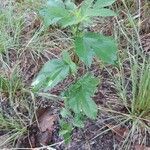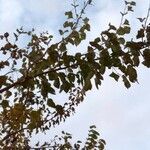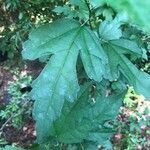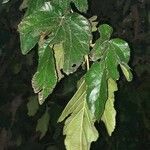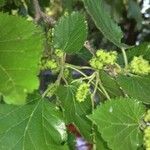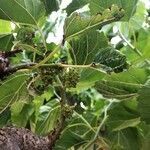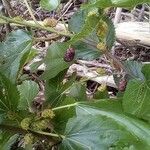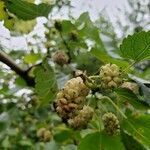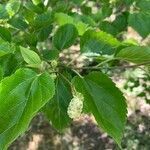Shrubs or trees , to 15 m. Bark brown tinged with red or yellow, thin, shallowly furrowed, with long, narrow ridges. Branchlets orange-brown or dark green with reddish cast, pubescent or occasionally glabrous; lenticels reddish brown, elliptic, prominent. Buds ovoid, 4-6 mm, apex acute to rounded; outer scales yellow-brown with dark margins, glabrous or with a few marginal trichomes; leaf scars half round, bundle scars numerous, in circle. Leaves: stipules ovate to lanceolate, 5-9 mm, pubescent; petiole 2.5-5 cm, short-pubescent. Leaf blade ovate, often deeply and irregularly lobed, (6-)8-10 × 3-6 cm, base cuneate, truncate, or cordate, margins coarsely serrate to crenate, apex acute to short-acuminate; surfaces abaxially glabrous or sparingly pubescent along major veins or in tufts in axils of principal lateral veins and midribs, adaxially glabrous to sparsely pubescent. Catkins: peduncle and axis pubescent; staminate catkins 2.5-4 cm; pistillate catkins 5-8 mm. Flowers: staminate and pistillate on same or different plants. Staminate flowers: sepals distinct, green with red tip, ca. 1.5 mm, pubescent; filaments ca. 2.7 mm. Pistillate flowers: ovary green, ovoid, slightly compressed, ca. 2 mm, glabrous; style branches divergent, red-brown, 0.5-1 mm; stigma papillose. Syncarps red when immature, becoming black, purple, or nearly white, cylindric, 1.5-2.5 × 1 cm; achenes light brown, ovoid, 2-3 mm.
Shrubs or trees, 3-10 m tall. Bark gray, shallowly furrowed. Branches finely hairy. Winter buds reddish brown, ovoid, finely hairy. Stipules lanceolate, 2-3.5 cm, densely covered with short pubescence. Petiole 1.5-5.5 cm, pubescent; leaf blade ovate to broadly ovate, irregularly lobed, 5-30 × 5-12 cm, abaxially sparsely pubescent along midvein or in tufts in axil of midvein and primary lateral veins, adaxially bright green and glabrous, base rounded to ± cordate, margin coarsely serrate to crenate, apex acute, acuminate, or obtuse. Male catkins pendulous, 2-3.5 cm, densely white hairy. Female catkins 1-2 cm, pubescent; peduncle 5-10 mm, pubescent. Male flowers: calyx lobes pale green, broadly elliptic; filaments inflexed in bud; anthers 2-loculed, globose to reniform. Female flowers: sessile; calyx lobes ovoid, ± compressed, with marginal hairs; ovary sessile, ovoid; style absent; stigmas with mastoidlike protuberance, branches divergent, papillose. Syncarp red when immature, blackish purple, purple, or greenish white when mature, ovoid, ellipsoid, or cylindric, 1-2.5 cm. Fl. Apr-May, fr. May-Aug.
Tree or large shrub to 15 m high. Leaves alternate; lamina narrowly to broadly ovate, 4–15 cm long, 3–10 cm wide, (cuneate to) truncate to cordate at base, dentate-serrate to variously lobed margin (especially in juvenile stages), acute or very shortly acuminate at apex, palmately 3-veined with 2 or 3 primary veins above on each side of midrib, usually glossy, glabrous or slightly scabrous above, glabrous or slightly pilose below on veins; petiole 1.5–4 cm long. Male and female catkins 5–30 mm long (male spikes drooping, 20–30 mm long, female spikes shorter than the male, fide Harden 1990: 347), on pubescent peduncles 5–10 mm long. Fruits (a multiple fruit) 2–3 cm long, fleshy, when ripe whitish, pink, reddish purple, purplish or black (may mature from white to red to black).
Deciduous tree, 3-10 m high, crown rounded. Leaves thinly textured, very variable, entire to deeply incised, ovate to narrowly ovate, 50-250 x 20-160 mm, upper surface glabrous, smooth, subglossy, lower surface glabrous, usually with hair tufts in vein axils, apex acute, base cordate to truncate, margins coarsely serrate to dentate, venation raised below, cream-coloured, basal 3 veins forming a ‘V’; petioles 10-35 mm long. Male inflorescence an axillary catkin, ± 25 mm long, calyx lobes ovate. Female inflorescence pedunculate, cylindrical, 8-15 mm long, styles free to base, style arms glabrous to glabrescent. Syconia compound, fleshy, cylindrical, 15-60 mm long, whitish, ripening to white, pink or purple-black; edible.
A small tree up to 9 m high but it can grow to 20 m tall. Often it is low and spreading. It has dark green toothed leaves. The leaves vary considerably in shape even on the one tree. They can be oval, heart shaped or 3 lobed and 5-15 cm long. The tip is pointed and the leaf is on a stalk 5 cm long. The upper surface is smooth but there can be some hairs on the veins underneath. Male and female flowers occur separately either on the same or separate plants. The flowers are greenish and in spikes which droop down. The fruit is a dark red or black berry but pale kinds also occur. The fruit is about 2 cm long.
Tree to 15 m; lvs glabrous or nearly so, or with white, spreading hairs along the veins beneath, acute or short-acuminate, otherwise as in no. 1 [Morus rubra L.]; fr white, pink, or pale purple to nearly black; 2n=28. Native of e. Asia, often escaped from cult. in our range.
